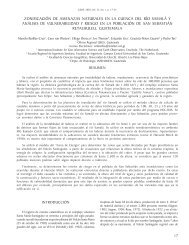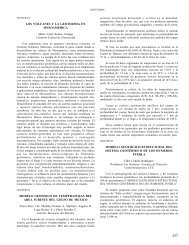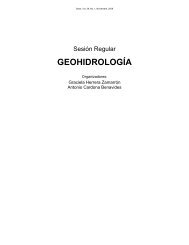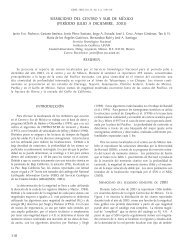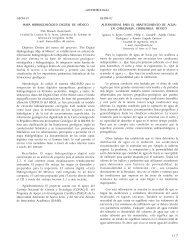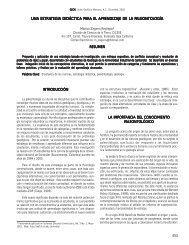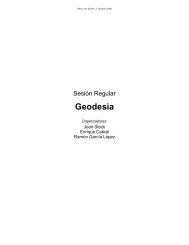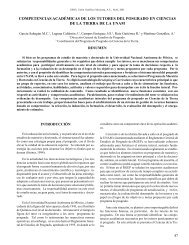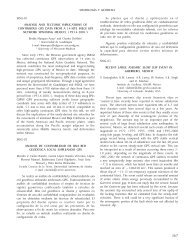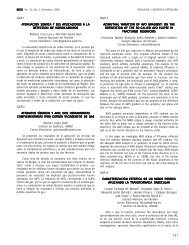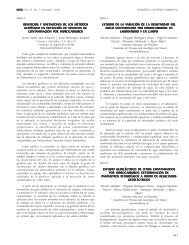Libro de resúmenes - Unión Geofisica Mexicana AC
Libro de resúmenes - Unión Geofisica Mexicana AC
Libro de resúmenes - Unión Geofisica Mexicana AC
You also want an ePaper? Increase the reach of your titles
YUMPU automatically turns print PDFs into web optimized ePapers that Google loves.
ESCENARIO 2011: ESTUDIOS SOBRE UN TEMBLOR HIPOTÉTICO ENGUERREROGeos, Vol. 31, No. 1, Noviembre, 2011Se invierten valores <strong>de</strong> PGA para <strong>de</strong>terminar efectos <strong>de</strong> sitio utilizando unaecuación básica <strong>de</strong> atenuación y una ecuación elaborada por el espectro <strong>de</strong>la señal (Arroyo et al., 2010). Los valores <strong>de</strong> efectos <strong>de</strong> sitio fueron utilizadospara crear un escenario <strong>de</strong> un sismo <strong>de</strong> Mw=7.8 para la RAS. Se comparan losefectos <strong>de</strong> sitio y las ecuaciones con valores obtenidos <strong>de</strong>l M 5.5 <strong>de</strong> 26 <strong>de</strong> abril<strong>de</strong> 2011. Se encuentra que los valores <strong>de</strong> PGA prevista no son a<strong>de</strong>cuados para<strong>de</strong>terminar los valores reales.SE04-10SISMICIDAD INDUCIDA EN LA CUENCA DE MÉXICOPOR EL SISMO DE ‘LA BRECHA DE GUERRERO’Rodríguez González Miguel 1 y Quintanar Luis 21 Instituto <strong>de</strong> Ingeniería, UNAM2 Instituto <strong>de</strong> Geofísica, UNAMmrod@gea.iingen.unam.mxLa presentación trata <strong>de</strong> la actualización <strong>de</strong>l catálogo <strong>de</strong> sismos localesregistrados en la cuenca <strong>de</strong> México, para conocer si ha habido incremento <strong>de</strong> lasismicidad local, relacionado con sismos fuerte ocurridos a lo largo <strong>de</strong> la costa<strong>de</strong>l Pacífico mexicano, en la zona <strong>de</strong> subducción.SE04-11BUSCANDO LOS TREMORES NO-VOLCÁNICOS (NVT)DISPARADOS POR UN TERREMOTO M8.2 OCURRIDO EN MÉXICOPayero De Jesús Juan Silvestre 1 , KostoglodovVladimir 2 , Husker Allen 2 y Real Pérez Jorge Arturo 21 Instituto <strong>de</strong> Geofísica/Posgrado Ciencias <strong>de</strong> la Tierra, UNAM2 Instituto <strong>de</strong> Geofísica, UNAMpayero@ollin.igeofcu.unam.mxThe group does not count yet of a constant financial support in case of anearthquake. It is one point we should solve in the next future. This group mayalso be exten<strong>de</strong>d in the future for any intervention on active volcanoes in México.Invitamos a toda otra persona participar a ese grupo.SE04-13SISTEMA DE EVALU<strong>AC</strong>IÓN DE DAÑO SÍSMICOTEMPRANO DE ALTA RESOLUCIÓN EN LA CIUDADDE MÉXICO BASADO EN UNA SOLA EST<strong>AC</strong>IÓNOrdaz Mario, Jaimes Miguel A., Reinoso Eduardo, Alcántara Leonardo y Pérez CitlaliInstituto <strong>de</strong> Ingeniería, UNAMmors@ii.unam.mxSe presenta un sistema <strong>de</strong> evaluación <strong>de</strong> daño sísmico temprano <strong>de</strong> altaresolución para la Ciudad <strong>de</strong> México basado en intensida<strong>de</strong>s espectralessísmicas calculadas en tiempo real en un sitio <strong>de</strong> referencia (CiudadUniversitaria, CU). Para obtener las intensida<strong>de</strong>s para todo el valle <strong>de</strong> México,se usan relaciones espectrales <strong>de</strong> respuesta pre-calculadas en sitios blandos <strong>de</strong>la ciudad. Con las estimaciones <strong>de</strong> intensida<strong>de</strong>s sísmicas (aceleración máxima<strong>de</strong>l suelo, velocidad máxima <strong>de</strong>l suelo y or<strong>de</strong>nadas espectrales para periodosestructurales seleccionados), junto con las relaciones <strong>de</strong> intensidad-dañopara edificios, fatalida<strong>de</strong>s y red <strong>de</strong> agua potable, se obtiene la distribuciónespacial en toda la ciudad <strong>de</strong> daños esperados en edificios, fatalida<strong>de</strong>s y dañoen la red <strong>de</strong> agua potable. El proceso toma aproximadamente 10 minutossin intervención humana. Debido a que el tiempo para realizar todos loscálculos es corto, se construyó una base <strong>de</strong> datos representativa <strong>de</strong> edificiosy población que concentra en una malla cuadrada <strong>de</strong> 400 x 400 m todala información. Los resultados son enviados a un Centro <strong>de</strong> Emergenciay a tomadores <strong>de</strong> <strong>de</strong>cisiones para <strong>de</strong>tonar los planes <strong>de</strong> emergencia quepreviamente <strong>de</strong>ben haber sido elaborados y proveer información antes que losplanes <strong>de</strong> emergencia sean totalmente <strong>de</strong>sarrollados.El estudio <strong>de</strong> la actividad <strong>de</strong> Tremores No-Volcánicos (NVT) ha ido en aumento,<strong>de</strong>s<strong>de</strong> que se reportaran por primera vez (Obara, 2002) en Japón. Los disparos<strong>de</strong> NVT inducidos, <strong>de</strong>spués <strong>de</strong> un gran sismo, se han reportado para diferentespartes <strong>de</strong>l mundo: Cascadia, San Andrés California, Alaska, Taiwan, México yotros lugares. La ocurrencia <strong>de</strong> un terremoto M8.2 en México producirá una granactividad tanto en la zona cercana como en la lejana, efectos reportados paraotros eventos. La intensidad y duración <strong>de</strong> estos NVT está en función <strong>de</strong> variosparámetros entre ellos la magnitud, azimut, la tectónica regional.En la simulación <strong>de</strong> este sismo M8.2 analizamos las características <strong>de</strong> las ondassuperficiales, generadas en algunos lugares para <strong>de</strong>terminar la probabilidad<strong>de</strong> disparos <strong>de</strong> NVT, comparados con eventos reales. Mostramos la formaautomática <strong>de</strong> producir los resultados a partir <strong>de</strong> datos <strong>de</strong>l SSN y posteriormentemejorados mediante la inserción <strong>de</strong> datos <strong>de</strong> réplicas <strong>de</strong> re<strong>de</strong>s temporalesy autónoma (caso G-GAP). Estimamos el tiempo en que se producirán lasactivida<strong>de</strong>s NVT inducidas.SE04-12CREATION OF AN AFTERSHOCK GROUP IN ORDER TO RECORD ANDPROCESS AFTERSHOCKS OF A POTENTIAL MEXICAN EARTHQUAKELegrand Denis, Iglesias Mendoza Arturo, Husker Allen, Pérez-CamposXyoli, Valenzuela Wong Raúl, Cruz-Atienza Víctor M., Valdés GonzálezCarlos, Sánchez Osvaldo, Hjorleifsdottir Vala y Group Stu<strong>de</strong>ntInstituto <strong>de</strong> Geofísica, UNAM<strong>de</strong>nis@geofisica.unam.mxWe are forming a group (Aftershock Group) in or<strong>de</strong>r to record and processaftershocks of a mainshock that could occur in Center-South of Mexico. Thisgroup is composed of permanent staff and stu<strong>de</strong>nts. The Department ofSeismology already count with 4 broad-band stations, and have financial supportfor 4 more broad-band stations. We propose to form a team that will be able to:1. Install seismological stations2. Collect data3. Process the data in quasi real time: mainly locate aftershocks; calculatemagnitu<strong>de</strong>; establish basic statistics (Omori’s and Gutenberg-Richter laws) andif possible <strong>de</strong>termine focal mechanisms of the greatest aftershocks.4. Disseminate of the results and outreach to the public.These 4 points will be followed by scientific studies to un<strong>de</strong>rstand the ruptureprocess of the earthquake. It will be, in association with the mo<strong>de</strong>ling group (seeothers in this section).The group should have some common targets: 1. communication (insi<strong>de</strong> andoutsi<strong>de</strong> the group) 2. Redundancy, 3. In<strong>de</strong>pen<strong>de</strong>nce and 4. Efficiency152



![Libro de resúmenes [revisión final, 172 páginas] - UGM](https://img.yumpu.com/51565067/1/190x245/libro-de-resamenes-revisian-final-172-paginas-ugm.jpg?quality=85)
